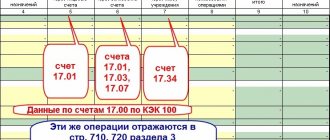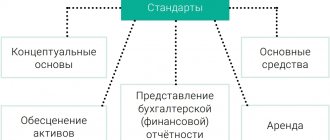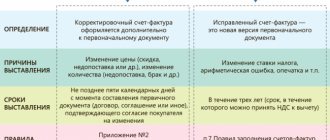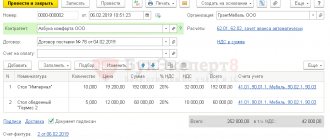How to organize accounting of workwear
Institutions are required to provide their employees with personal protective equipment when performing work functions.
This is evidenced by the Order of the Ministry of Health and Social Development of Russia dated 01.06.09 No. 290n. What kind of special clothing a given employee needs is determined based on the results of workplace certification. Certification also determines how protective equipment should be certified to perform a specific job. For simplicity, the term “working clothing” combines the concepts of “special clothing”, “special footwear” and “personal protective equipment”. The cost and shelf life of workwear items may be different, but in any case they are considered soft inventory, for which accounts of the type 0 105X5 000 are intended (Instruction No. 157n “On approval of a unified chart of accounts...”):
- 0 10525 000 “Soft inventory - especially valuable movable property of an institution”;
- 0 10535 000 “Soft inventory - other movable property of the institution.”
Changes in accounting instructions in 2021
S.A.
Ratovskaya, expert consultant at the Publishing House “Accountant's Adviser” In 2021, significant changes are being made to all accounting instructions in institutions. The changes are related to the new procedure for applying KOSGU, the entry into force of several federal accounting standards in 2021, and clarification of the procedure for off-balance sheet accounting of individual objects.
The Ministry of Finance of Russia approved the following orders on changes to the instructions: Name of the instructions Order of the Ministry of Finance of Russia Registered with the Ministry of Justice of Russia on the application of the Unified Chart of Accounts, approved. by order of the Ministry of Finance of Russia dated December 1, 2010 No. 157n 01/29/2021 No. 53597 on budget accounting, approved. by order of the Ministry of Finance of Russia dated December 6, 2010 No. 162n 01/29/2021 No. 53598 on accounting in budgetary institutions, approved.
by order of the Ministry of Finance of Russia dated December 16, 2010 No. 174n 01/29/2021 No. 53600 on accounting in autonomous institutions, approved. by order of the Ministry of Finance of Russia dated December 23, 2010 No. 183n 01/29/2021 No. 53601 These orders are applied in the formation of accounting policies and accounting indicators starting from 2021. Significant changes have been made in terms of joint application of federal accounting standards adopted to date.
For example, according to the new edition of Instruction No. 157n, the organization and maintenance of accounting is carried out by the accounting entity (centralized accounting) in accordance with the accounting policy formed in accordance with the federal accounting policy “Accounting policies, estimates and errors”, approved by order of the Ministry of Finance of Russia dated December 30, 2017 No. 274n (hereinafter referred to as the GHS “Accounting Policy”). Earlier in this paragraph it was specified in detail which sections the accounting policy of the institution should contain. Similarly, according to the new edition of Instruction No. 157n, correction of errors found in accounting registers is carried out in accordance with the “Accounting Policy”.
In accordance with Instruction No. 157n, as amended, accounting records are maintained in the currency of the Russian Federation - rubles, unless otherwise provided for accounting entities permanently operating outside the territory of the Russian Federation. The cost of accounting items expressed in foreign currency is subject to conversion into the currency of the Russian Federation (ruble equivalent).
In this case, the conversion rate is determined taking into account the provisions of federal accounting “The Impact of Changes in Foreign Currency Rates”, approved by Order of the Ministry of Finance of Russia dated May 30, 2018 No. 122n. Previously, Instruction No. 157n directly described how the recalculation was carried out.
Thus, the norms become reference, and the content is determined by federal standards. The remaining changes can be divided into three groups: 1) depreciation; 2) income and expenses; 3) off-balance sheet accounts.
Arrival of workwear
Workwear is registered with the institution at its actual cost. What does this cost consist of? The basis, of course, is the cost of the clothing itself. To this are added additional costs for delivery, payment for intermediaries, duties, and other possible expenses that arose during the purchase and preparation for use. The accountant first collects all these amounts in account 0 10600 000 “Investments in non-financial assets”. Only after this can the workwear be accepted for registration.
Please note: you cannot change the actual cost of workwear after it has been registered (clause 107 of Instruction No. 157n).
If there were no additional costs, then the workwear is credited directly to the account 0 105X5 000. Let's look at this option using an example.
Example 1.
State Budgetary Educational Institution “Technical School of Mechanical Engineering”, using subsidies for the implementation of state assignments, purchased 10 sets of workwear for teachers of technical disciplines from LLC “Sila”. Total cost - 59,000 rubles, including VAT - 9,000 rubles. The institution also transferred 2,360 rubles (excluding VAT) to the transport company as payment for delivery. Let's assume that the purchased workwear is not particularly valuable property.
The GBOU accountant must generate the following entries:
| Contents of operation | Debit | Credit | Amount, rub. |
| The purchase price of the kits and the debt to Sila LLC are reflected | 4 10634 340 | 4 30234 730 | 59 000 |
| Money was transferred to Sila LLC | 4 30234 830 | 4 20111 610 | 59 000 |
| Transport costs and debt to Mig LLC are reflected | 4 10634 340 | 4 30222 730 | 2 360 |
| The debt to Mig LLC was repaid | 4 30222 830 | 4 20111 610 | 2 360 |
| The actual cost of workwear has been generated | 4 10535 340 | 4 10634 340 | 61 360 |
Let us note that different types of institutions have their own nuances of accounting for workwear. For example, government institutions receive it as part of centralized supply. The transfer is documented by means of a notice (f. 0504805).
Postings depend on the budget level and status of the institution:
| Contents of operation | Debit | Credit |
| The overalls came from other subordinate institutions within the department | 0 10535 340 | 0 30404 340 |
| The overalls were received from institutions that are under the control of different managers of the same budget level, or subordinate to the same GRBS as part of income-generating activities (similar postings will be made when receiving clothing from individuals). | 0 10535 340 | 0 40110 180 |
| The overalls were received from a budgetary institution of a different budget level | 0 10535 340 | 0 40110 151 |
Having received the protective clothing, the institution is obliged to mark it. The procedure is controlled by managers and accountants. The procedure for marking soft equipment is described in detail in paragraph 118 of Instruction No. 157n.
What off-balance sheet accounts exist in budgetary organizations
The reference books of any accountant in a budgetary institution are the chart of accounts and instructions for its use No. 174n. The documents were approved by the Ministry of Finance by order dated December 16, 2010. It is this instruction that contains the list of off-balance sheet accounts provided for in budgetary organizations. The list consists of 31 items: 27 main ones (1 to 27) and four additional ones (30, 31, 40 and 42). This makes accounting in budgetary organizations different from accounting in commercial companies, for which only 11 off-balance sheet accounts are provided.
So, what are the off-balance sheet accounts for public sector employees?
Account 01. Property received for use
It takes into account real estate and other property that is received for free use. Vehicles in paid use (except for rent) that are on the balance sheet of the lessee are also reflected here. The fact of transfer of property from the owner to the user is fixed in the transfer and acceptance certificate. It also states the cost of the object, at which it will be held in off-balance sheet account 01.
Interesting fact! Off-balance sheet accounts 01 account for exhibits and collections of the museum fund of the Russian Federation, which are stored in state and municipal museums.
Account 02. Valuables accepted for storage
This account accounts for a number of assets:
- items sent for recycling;
- ownerless things;
- scrapped equipment;
- property seized as compensation for harm;
- goods detained at customs;
- etc.
The property is accepted for storage with the preparation of a primary document in which the transferring party indicates its value. If values are accepted unilaterally, a conditional price of one ruble is indicated.
Account 03. Strict reporting forms
Such forms include:
- work books and inserts in them;
- templates for certificates and diplomas;
- certificates and certificates;
- sick leave;
- blank receipts;
- etc.
Reception, storage, disposal, and write-off of these forms are accounted for in off-balance sheet account 03.
Account 04. Written off debt of insolvent debtors
Debts are recorded in an off-balance sheet account after a special commission decides to write them off from the main balance sheet. The debt will be taken into account until the debtor’s property status changes and he repays the debt, or until the debt is fulfilled or terminated in another way that does not contradict the law.
Invoice 05. Assets paid for through centralized supply
This account can be used by consignee institutions that ship valuables and then transfer them to customers. On the off-balance sheet account, cargo is reflected at the purchase price and then written off at the same price.
Account 06. Debt of students and pupils for unreturned valuables
The amount of debt is taken into account as the amount of expenses for restoring old or purchasing new property. The numbers are reflected on cards for each student, type of admission and value.
Account 07. Awards, valuable gifts, souvenirs
Awards, prizes, cups and banners are registered at a conditional price of one ruble. Valuable gifts, souvenirs and other items purchased for remuneration are reflected at the cost at which they were purchased.
Invoice 08. Unpaid trips
Unpaid vouchers are accepted into an off-balance account after the expiration of their storage period at the cash desk. They are registered either at the face value indicated on the voucher, or at a conditional valuation of one ruble, if there is no face value.
Account 09. Spare parts for vehicles
Spare parts begin to be accounted for off-balance sheet after they are used to repair a vehicle. At this moment, they are written off from the balance sheet and are recorded in off-balance sheet account 09 throughout their entire operational life.
Account 10. Ensuring the fulfillment of obligations
This account records the property received by the institution as part of interim measures:
The value of such property is recorded as the sum of the obligations that it secures. At the same cost, it is removed from off-balance sheet accounting.
Account 11. State and municipal guarantees
This account reflects all types and amounts of guarantees given and received for certain civil obligations. Entries on arrivals and departures are made for the amounts of obligations for which guarantees have been received.
Account 12. Special equipment for carrying out scientific research under contracts with customers
This account is necessary for institutions that carry out research work on special orders. Off-balance sheet account 12 takes into account the equipment necessary for such work. It arrives and departs at the cost specified by the customer in the relevant contract.
Account 13. Experimental devices
This account also takes into account equipment that is necessary for research work, but is classified as experimental.
Account 14. Payment documents awaiting execution
This account records all amounts for which settlement documents have been issued.
Invoice 15. Payment documents not paid on time due to lack of money on the balance sheet of the budget organization
This account records all amounts of debt that the budgetary institution was unable to repay on time. Debts are removed from the balance sheet upon expiration of their repayment period, but remain off-balance sheet.
Account 16. Overpayments on pensions and benefits due to incorrect application of laws and accounting errors
Overpayment amounts are placed on off-balance sheet records based on audits or checks and are listed there until they are fully repaid or written off.
Account 17. Cash receipts
Off-balance sheet account 17 is opened as an annex to three current balance sheet accounts. It is necessary for analytical accounting of the receipt of money, the return of excess income, and the return of accounts receivable from previous years.
Account 18. Cash outflows
The account is opened in addition to the same settlement balance accounts as the previous one. It is necessary for analyzing cash outflows, refunds of excess expenses, etc.
Account 19. Unknown revenues to the budgets of previous years
The account takes into account the dates of unknown deposits and clarification of their volumes.
Account 20. Debt not claimed by creditors
This account records the amounts of debts that have not been confirmed by creditors based on the results of their audits. They remain registered during the limitation period, and then are written off as income of the budget organization.
Account 21. Fixed assets (up to three thousand rubles) in operation
This account records the enterprise's fixed assets worth up to three thousand rubles inclusive, which are in active use. The exception is real estate and library assets. Funds are registered at a conditional value of one ruble.
Account 22. Assets received through centralized supply
Such property is accounted for in this account until the supplier submits all the necessary supply documents.
Account 23. Periodicals for use by management and employees
This takes into account newspapers, magazines and other periodicals that a budgetary institution buys for its needs. Accounting is carried out at a conditional value of one ruble.
Account 24. Items placed in trust
An account is necessary to control assets, including real estate, transferred to trust management.
Account 25. Items leased
This account is needed to analyze assets leased. It helps ensure their safety and proper use. It takes into account the location of the property, its types, quantity, and cost.
Account 26. Items given for free use
This takes into account any property that a budget institution has given to someone for free use. The entry is made on the basis of the primary act, which establishes the value of the transferred property.
Account 27. Valuables issued to workers for personal use
This account records work clothes, uniforms and other property that is issued to employees to perform their official duties.
Four more counts 30, 31, 40 and 42 are considered additional. They take into account:
- monetary transactions carried out through third parties;
- shares with par value;
- assets managed by management companies;
- budget investments being implemented.
Also, budgetary institutions have the right to create other off-balance sheet accounts if they need to collect additional information or strengthen control over property and transactions.
Internal movement of workwear
Soft inventory can move from unit to unit during operation. It can also be written off from a dismissed materially responsible person (MRP) and reported to a newly hired employee.
Internal displacement is recognized as:
- return of property to the warehouse, for example upon dismissal;
- independent tailoring of workwear;
- delivery from warehouse to reporting;
- transfer of used workwear to the replacement fund;
- handing over workwear to a laundry, dry cleaning or repair shop.
If you are writing off clothes from one shopping center to another, draw up a demand invoice (f. 0315006), in which those responsible will put personal signatures. If the accounting policy of a government agency determines that materials are written off upon receipt of a document on their use from a structural unit, reflect the operation with the following entries:
| Contents of operation | Debit | Credit |
| Special clothing was transferred from one MOL to another | 0 10535 340 | 0 10535 340 |
Issuing uniforms to employees
We have already mentioned that the quantity and list of protective clothing transferred to financially responsible persons depends on the results of workplace certification. To reflect the issue in accounting, use account 0 105X5 000 and off-balance sheet account 27. It will be convenient if analytics are carried out on these accounts in the context of MOL. Any movements of special clothing should be recorded on the material assets accounting card (f. 0504043).
Maintain budget accounting and generate reports in the Kontur-Accounting Budget program
When issuing special clothing directly to employees, the storekeeper fills out two documents: a demand invoice (f. 0315006) and a statement of issue of material assets for the needs of the institution (f. 0504210). Accounting, based on available documents, writes off the property from account 0105X5 000 and moves it to the off-balance sheet. For off-balance sheet accounting, account 27 “Material assets issued for personal use to employees (employees)” was created, which helps to monitor the safety of property. Analytics for this account is carried out in the quantitative and total accounting card (f. 0504041).
The issuance of clothing to employees is considered the beginning of its use. Do not forget to carry out additional labeling, indicate the month and year of issue from the warehouse. This data will come in handy when it comes time to write off your protective equipment.
What is what
Don't know what an off-balance sheet account is in accounting? In the working charts of accounts used in accounting in both budgetary and commercial and non-profit organizations, main (balance sheet) and off-balance sheet accounts are distinguished. On the main accounts, accountants must conduct transactions related to the movement of cash and other material assets, receipts and disposals, profits and mutual settlements with counterparties; information about various goods and works, as well as advertising and other services are taken into account. Off-balance sheet accounts are used to account for inventory items that are temporarily at the disposal of the organization and do not belong to it as property. Off-balance sheet accounts are also needed to reflect transactions on those obligations that are awaiting fulfillment, and the movement of values not intended for accounting on the main accounting accounts.
Such accounts are auxiliary accounting accounts. The balances for them are not included in the balance sheet and are illustrated behind the results of the main balance sheet, that is, behind the balance sheet. They do not affect the financial result and are not reflected in the periodic and final reports of the organization.
Balance sheet accounts are opened by enterprises for the following cases:
- Keeping records of property that either does not belong to him or is written off as expenses.
- Collection of information that must be indicated in the subject of the explanatory note to the balance sheet and final reporting.
Off-balance sheet accounts in budgetary institutions in 2021 are regulated by the Chart of Accounts approved by Order of the Ministry of Finance of the Russian Federation No. 157n dated December 1, 2010 (Instruction No. 157n). The procedure for maintaining balance sheet accounting for non-profit organizations is established by Order of the Ministry of Finance of the Russian Federation No. 94n dated October 31, 2000. They are also regulated by 402-FZ “On Accounting” dated December 6, 2011 and the Civil Code of the Russian Federation. Having these legal acts at hand, it is much easier and clearer to conduct accounting for off-balance sheet accounts.
Disposal of workwear
The reason for writing off workwear may be:
- dismissal of the employee who used it;
- expiration of useful life;
- complete wear and tear of workwear.
In the first two cases, the employee must hand over the workwear to the warehouse.
For write-off, use accounts 0 10900 000 “Costs for the manufacture of finished products, performance of work, services” or 0 40120 000 “Expenses of the current financial year”.
There are two ways to write off workwear:
- at the actual cost of each unit;
- at the average actual cost.
In practice, institutions prefer to write off workwear at the actual cost of each unit. If you choose the second option, do so by inventory group separately. The total actual cost of the group takes into account the average actual cost and balance at the beginning of the month, as well as items received during the current month. This amount is divided by the number of objects on the write-off date.
After a decision has been made to deregister several objects, the commission for the receipt and disposal of assets draws up an Act on the write-off of soft and household equipment (f. 0504143). The act must indicate the reason for the write-off, for example, physical wear and tear, etc. The document is drawn up in two copies and signed by all members of the commission. One copy is submitted to the accounting department, and the second remains with the financially responsible employee.
Sometimes clothes wear out prematurely through no fault of the employee. The reason may be the nature of the institution's activities. In this case, use the wiring shown in example 2.
Example 2.
During the production process, the work suit of the foreman of the training workshop at the State Autonomous Institution "Technical Lyceum" was damaged. The initial cost of the suit is 7,000 rubles. After completing the relevant documents, the following entries will be made in accounting:
| Contents of operation | Debit | Credit | Amount, rub. |
| The cost of a suit that has become unusable has been written off. | 0 40120 272 | 0 10535 440 | 7 000 |
Disposal of special clothing due to emergency circumstances is reflected in the debit of account 0 40120 273 “Extraordinary expenses from operations with assets.” Discarded clothing can be used as rags.
How accounting is carried out in government institutions
- The founder participates in financial management.
- Accounts are opened in the treasury.
- Financing is carried out within the budget.
- Income from work goes to the budget.
- The institution does not have ownership rights to the property.
- Transactions with securities are not carried out.
- The structure does not have the rights to use the simplified tax system.
- Acceptance of OS for registration is carried out on the basis of a decision of the commission. The primary document is the transfer deed.
- The right of management is formed from the date of registration.
- Property valuation is carried out on the basis of the value stated in the deed.
- Cost adjustments are made based on the modernization carried out.







